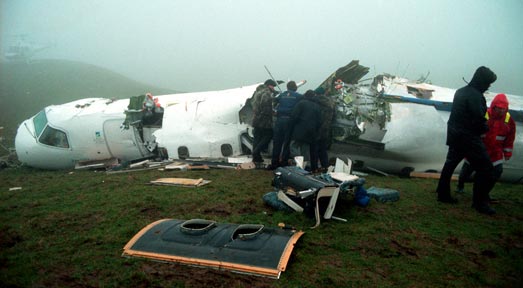Date: 9 June 1995
Time: 0922
Location: Tararua Ranges, New Zealand
Registration: ZK-NEY
Aircraft type: De Havilland DHC-8
POB:21
Fatalities:4
Airplane damage: Written off
Airplane fate: Written off (damaged beyond repair)
Synopsis
This was a scheduled passenger flight that was flying from Auckland to Plamerston North. The aircraft crashed just West of the Tararua Ranges 16km East of the Palmerston North Airport, when the GPWS (Ground Proximity Warning System), failed and the landing gear failed to completely extend on approach to runway 25 of the airport. 4 of the passengers on-board died1.
 |
 |
|
| Ansett Aircraft ZK-NEY After Crash, Image Embedded from[http://www.teara.govt.nz/en/air-crashes] on 06 September 2010 | Ansett Aircraft ZK-NEY After Crash , Image Embedded from[http://www.baaa-acro.com/photos/Dash8-ZK-NEY-1.jpg] on 06 September 2010 | |
Flight History
This accident occurred at 0922 hours on Friday 9 June 1995 when a De Havilland DHC-8 aircraft, ZK-NEY, collided with the terrain just 16km East of the Palmerston North Airport, when the GPWS malfunctioned and the landing gear failed to properly retract. They were two pilots on board a Captain and a first officer co-pilot. The GPWS sounded a warning alarm only 4 seconds before crashing not giving the pilots any time to recover from the situation. Before the crash the co-pilot tried to start manually trying to extend the landing gear using a hydraulic pump. One of the passengers used a phone on-board the aircraft but during investigation this was not noted as a cause to the accident. The Transport Accident Investigation Commission (TAIC), which is a safety body of New Zealand carried out an investigation into the causes of the crash which are addressed below1.
The Findings of the Transport Accident Investigation Commission
1. The Captain failed to ensure that the aircraft intercepted and maintained the approach profile during the conduct of the non-precision instrument approach2.
2. The Captain persisted with trying to get the undercarriage lowered without discontinuing the instrument approach2.
3. The Captain drifted from his primary task of flying the plane and started trying to help the co-pilot who was trying to manually extend the landing gear using a hydraulic pump2.
4. The Captain advised the first officer to skip some procedures on the Quick Reference Handbook (QRH) leading to the first officer not properly executing the procedures in the required order3.
5. Civil Aviation Authority’s (CAA)audit staff of that airline failing to discover weaknesses in operational procedures carried out by the Ansett Airline 3.
6. The GPWS warning was also discovered to have offered a very short alarm time of 4.5 to 4.8 sec. A study that was carried out by two airlines and included in the TAIC report stated that the average reaction time for pilots in response to the GPWS was 5.4 Sec 4.
Recommendations by the Transport Accident Investigation Commission 3
1. Continuous monitoring of the flight especially when dealing with abnormal system operation.
2. The Captain being able to assume manipulative control of the aircraft especially in times of abnormal occurrences in-flight.
3. Efficiency of the operator's follow-up on their decision not to modify the aircraft's undercarriage.
4. Quick Reference Handbook Checklists(QRH) should be used.
5. Implementation of a minimum safe altitude warning system for the Air Traffic Control Radar.
6. Ensuring passengers onboard do abide by safety equipment that can and can't be operated while in flight.
7. Ensuring proper maintenance and standard operation of the GPWS at all times.
Human Factors Analysis and Classification (HFACS)
Unsafe Acts
Skill-based Errors
The Captain failed to ensure that the aircraft intercepted and maintained the approach profile during his non-precision instrument approach.
Decision-Errors
Captain started helping the co- pilot try to fix the problem with the landing gear instead of performing his primary duty of flying the aircraft.
Violations
Routine Violations
Failure of the co-pilot to carry out the proper sequence of checks in the Quick Reference Handbook Checklist.
Conclusions
The Ground Proximity Warning System is there to aid the pilot in ensuring that he / she does not fly the aircraft intentionally into the ground. However it is an aid and it’s not meant to be used to replace the ability of the pilot to safely fly the aircraft. The pilot must ensure at all times that they have control of the aircraft. Although the biggest contribution to this crash was the failing of the GPWS which did not allow the pilots enough time to react, they were other contributing factors that have to do with the pilots performance and errors they performed that all lead up to the accident. Situational awareness as well as constant vigilance in ensuring the flight is flying on the required profile is paramount. Ensuring the proper execution of checks in cases of flight abnormality as well as in normal flight is required. The recommendations also offered by TAIC should always be applied in order to prevent accidents.
References
1.Aviation Safety Network,(2010). Flight Safety Foundation: Accident Description. Retrieved 06, September,2010, from
http://aviation-safety.net/database/record.php?id=19950609-0
2.TAIC,(2007).Occurrence Report Details. Report Details. Investigation 95-011:de Havilland DHC-8 ZK-NEY, controlled flight into terrain, near Palmerston North, 9 June 1995. Retrieved 03, September,2010, from http://www.taic.org.nz/AviationReports/tabid/78/ctl/Detail/mid/482/InvNumber/1995-011/Page/14/Default.aspx?SkinSrc=
3.Guerin, M,.(2001).Dash 8 Down: The Inside Story of Ansett Flight 703. The Report of the Transport Accident Investigation Commission. Auckland Random House New Zealand.
4.Phelan., P. (1997). Flight Global: New Zealand officials examine delayed crash warning. Retrieved 06, September,2010, from
http://www.flightglobal.com/articles/1997/08/20/14462/new-zealand-officials-examine-delayed-crash-warning.html
Want to know more?
http://en.wikipedia.org/wiki/Ansett_New_Zealand_Flight_703
To find out more about the Human Factors Analysis and Classification System: AviationKnowledge - Human Factors Analysis and Classification Systems (HFACS)
http://aviationknowledge.wikidot.com/aviation:hfacs









